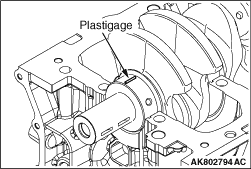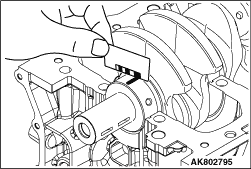|
|
The oil clearance can easily be measured by using a "plastigage."
|
|
|
When using the "plastigage," perform the measurement in the following procedures.
|
|
|
1.Fully wipe oil off the outside diameter of the crankshaft and the inside diameter
of the bearing.
|
|
|
2.Assemble the crankshaft.
|

|
3.Place the plastigage in length equal to the bearing width on the journal shaft straight
in alignment with the shaft centre.
4.Carefully install the lower crankcase and tighten the bolt according to the main points
to installation.
5.Remove the bolt, and then carefully remove the bearing cap.
|

|
6.Measure the crushed plastigage width (area most widely crushed) using the scale printed
on the plastigage bag.
If the measurement value exceeds the limits, replace the bearing.
Standard value: 0.029 -
0.047 mm
Limit: 0.1 mm
|
|
|
1.Visually check the cylinder block for scratch, rust and corrosion. Use a flaw detecting
agent to check for cracks. If it is found faulty, repair or replace it.
|

|
2.Use a straight edge and free gauge to measure distortion on the top surface of the cylinder
block.
If distortion exceeds the limit, grind and repair it.
A gasket or the like must not be adhered to the top surface of the cylinder block during
the measurement.
Limit: 0.05 mm
3.Check the cylinder wall for scratch or seizure. If there is any defect, replace the
cylinder block.
|

|
4.Use the cylinder gauge to measure the inside diameter and cylindricity of the cylinder.
If the cylinder is excessively worn, replace the cylinder block or the piston and piston
ring, or the both.
Measuring points are as shown in the illustration.
Standard value:
Cylinder inside diameter: 86 mm
Cylindricity: 0.0076 Max.
|
